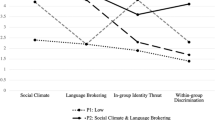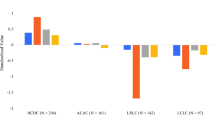Abstract
Depressive symptoms in Latino youth have been related to both culturally-universal and culturally-based stressors. However, few studies have examined the unique contributions of culturally-based stressors above and beyond other types of stressors. Moreover, no past studies with Latinos have examined the role of culturally-based stressors within a hopelessness model of depressive symptoms, a cognitive model with the strongest empirical support in adolescence. The current study examined these issues in a sample of 171 Latino adolescents (7th–10th grades; mean age = 14; 46 % male). The Latino adolescents were primarily Mexican–American (78 %) and born in the United States (60 %). Students completed measures during a school period on their experiences of parent–child conflict, economic stress, discrimination from peers, and acculturative stress as well as depressive symptoms and attributional style. The results indicated that culturally-based stressors (e.g., acculturative stress and discrimination) predicted greater depressive symptoms even when controlling for culturally-universal stressors (e.g., parent–child conflict, economic stress). Moreover, a negative attributional style moderated the relationship between culturally-universal stressors and depressive symptoms, but this was not the case for culturally-based stressors. Culturally-based stressors play an important role in depressive symptoms among Latino youth. These stressors predicted greater symptomatology even when controlling for other types of stressors and a negative attributional style. These findings suggest that there may be other cognitive risk factors associated with culturally-based stressors.

Similar content being viewed by others
References
Aiken, L. S., & West, S. G. (1991). Multiple regression: Testing and interpreting interactions. Thousand Oaks, CA: Sage.
Angold, A., Costello, E., Pickles, A., Winder, F., & Silver, D. (1987). The development of a questionnaire for use in epidemiological studies of depression in children and adolescents. Unpublished manuscript.
Berkel, C., Knight, G. P., Zeiders, K. H., Tein, J., Roosa, M. W., Gonzales, N. A., et al. (2010). Discrimination and adjustment for Mexican American adolescents: A prospective examination of the benefits of culturally related values. Journal of Research on Adolescence, 20(4), 893–915. doi:10.1111/j.1532-7795.2010.00668.x.
Bohon, C., Stice, E., Burton, E., Fudell, M., & Nolen-Hoeksema, S. (2008). A prospective test of cognitive vulnerability models of depression with adolescent girls. Behavior Therapy, 39(1), 79–90. doi:10.1016/j.beth.2007.05.003.
Cervantes, R. C., Padilla, A. M., & Salgado de Snyder, N. (1991). The Hispanic stress inventory: A culturally relevant approach to psychosocial assessment. Psychological Assessment: A Journal of Consulting and Clinical Psychology, 3(3), 438–447. doi:10.1037/1040-3590.3.3.438.
Corona, R., Lefkowitz, E. S., Sigman, M., & Romo, L. F. (2005). Latino adolescents’ adjustment, maternal depressive symptoms, and the mother-adolescent relationship. Family Relations, 54(3), 386–399.
Daviss, W. B., Birmaher, B., Melhem, N. A., Axelson, D. A., Michaels, S. M., & Brent, D. A. (2006). Criterion validity of the Mood and Feelings Questionnaire for depressive episodes in clinic and non-clinic subjects. Journal of Child Psychology and Psychiatry, 47, 927–934.
Delgado, M. Y., Updegraff, K. A., Roosa, M. W., & Umaña-Taylor, A. J. (2011). Discrimination and Mexican-origin adolescents’ adjustment: The moderating roles of adolescents’, mothers’, and fathers’ cultural orientations and values. Journal of Youth and Adolescence, 40(2), 125–139. doi:10.1007/s10964-009-9467-z.
Furman, W., & Buhrmester, D. (1985). Children’s perceptions of the personal relationships in their social networks. Developmental Psychology, 21(6), 1016–1024.
Garcia-Coll, C., Lamberty, G., Jenkins, R., McAdoo, H. P., Crnic, K., Wasik, B. H., et al. (1996). An integrative model for the study of developmental competencies in minority children. Child Development, 67(5), 1891–1914. doi:10.2307/1131600.
Gibb, B. E., & Alloy, L. B. (2006). A prospective test of the hopelessness theory of depression in children. Journal of Clinical Child and Adolescent Psychology, 35(2), 264–274.
Gibb, B. E., Alloy, L. B., Abramson, L. Y., Rose, D. T., Whitehouse, W. G., & Hogan, M. E. (2001). Childhood maltreatment and college students’ current suicidal ideation: A test of the hopelessness theory. Suicide and Life-Threatening Behavior, 31, 405–415. doi:10.1521/suli.31.4.405.22042.
Gibb, B. E., & Coles, M. E. (2005). Cognitive vulnerability-stress models of psychopathology: A developmental perspective. In B. L. Hankin & J. R. Z. Abela (Eds.), Development of psychopathology: A vulnerability stress perspective (pp. 104–135). Thousand Oaks, CA: Sage.
Greene, M. L., Way, N., & Pahl, K. (2006). Trajectories of perceived adult and peer discrimination among Black, Latino, and Asian American adolescents: Patterns and psychological correlates. Developmental Psychology, 42(2), 218–238.
Hankin, B. L., & Abramson, L. Y. (2001). A prospective test of the hopelessness theory of depression in adolescence. Cognitive Therapy and Research, 25(5), 607–632. doi:10.1023/A:1005561616506.
Hankin, B. L., & Abramson, L. Y. (2002). Measuring cognitive vulnerability to depression in adolescence: Reliability, validity and gender differences. Journal of Clinical Child and Adolescent Psychology, 31(4), 491–504.
Hovey, J. D., & King, C. A. (1996). Acculturative stress, depression, and suicidal ideation among immigrant and second-generation Latino adolescents. Journal of the American Academy of Child and Adolescent Psychiatry, 39(2), 1183–1192.
Hughes, D., Hagelskamp, C., Way, N., & Foust, M. D. (2009). The role of mothers’ and adolescents’ perceptions of ethnic-racial socialization in shaping ethnic-racial identity among early adolescent boys and girls. Journal of Youth and Adolescence, 38(5), 605–626. doi:10.1007/s10964-009-9399-7.
Huynh, V. W., & Fuligni, A. J. (2010). Discrimination hurts: The academic, psychological, and physical well-being of adolescents. Journal of Research on Adolescence, 20(4), 916–941. doi:10.1111/j.1532-7795.2010.00670.x.
Jacobs, R. H., Reinecke, M. A., Gollan, J. K., & Kane, P. (2008). Empirical evidence of cognitive vulnerability for depression among children and adolescents: A cognitive science and developmental perspective. Clinical Psychology Review, 28(5), 759–782. doi:10.1016/j.cpr.2007.10.006.
Joiner, T. E., Perez, M., Wagner, K. D., Berenson, A., & Marquina, G. S. (2001). On fatalism, pessimism, and depressive symptoms among Mexican-American and other adolescents attending an obstetrics-gynecology clinic. Behaviour Research and Therapy, 39, 887–896.
Kennard, B. D., Stewart, S. M., Hughes, J. L., Patel, P. G., & Emslie, G. J. (2006). Cognitions and depressive symptoms among ethnic minority adolescents. Cultural Diversity and Ethnic Minority Psychology, 12(3), 578–591. doi:10.1037/1099-9809.12.3.578.
Kuhlberg, J. A., Peña, J. B., & Zayas, L. H. (2010). Familism, parent-adolescent conflict, self-esteem, internalizing behaviors and suicide attempts among adolescent Latinas. Child Psychiatry and Human Development, 41(4), 425–440. doi:10.1007/s10578-010-0179-0.
Marmorstein, N. R., & Iacono, W. G. (2004). Major depression and conduct disorder in youth: Associations with parental psychopathology and parent-child conflict. Journal of Child Psychology and Psychiatry, 45(2), 377–386.
Mendoza-Denton, R., Pietrzak, J., & Downey, G. (2008). Distinguishing institutional identification from academic goal pursuit: Interactive effects of ethnic identification and race-based rejection sensitivity. Journal of Personality and Social Psychology, 95(2), 338–351. doi:10.1037/0022-3514.95.2.338.
Myers, H. F., & Rodriguez, N. (2002). Acculturation and physical health in racial and ethnic minorities. Acculturation: Advances in Theory, Measurement, and Applied Research, 27, 163–185. doi:10.1037/10472-011.
Oldehinkel, A. J., & Bouma, E. (2011). Sensitivity to the depressogenic effect of stress and hpa-axis reactivity in adolescence: A review of gender differences. Neuroscience and Biobehavioral Reviews, 35(8), 1757–1770. doi:10.1016/j.neubiorev.2010.10.013.
Paukert, A., Pettit, J., Perez, M., & Walker, R. (2006). Affective and attributional features of acculturative stress among ethnic minority college students. Journal of Psychology, 140(5), 405–419.
Preacher, K. J., Curran, P. J., & Bauer, D. J. (2006). Computational tools for probing interactions in multiple linear regression, multilevel modeling, and latent curve analysis. Journal of Educational and Behavioral Statistics, 31(4), 437–448.
Romero, A. J., Martinez, D., & Carvajal, S. C. (2007). Bicultural stress and adolescent risk behaviors in a community sample of Latinos and non-Latino European Americans. Ethnicity & Health, 12(5), 443–463.
Romero, A. J., & Roberts, R. E. (2003). Stress within a bicultural context for adolescents of Mexican descent. Cultural Diversity and Ethnic Minority Psychology, 9(2), 171–184. doi:10.1037/1099-9809.9.2.171.
Rosenbloom, S. R., & Way, N. (2004). Experiences of discrimination among African American, Asian American, and Latino adolescents in an urban high school. Youth & Society, 35(4), 420–451.
Rossello, J., Bernal, G., & Rivera-Medina, C. (2008). Individual and group CBT and IPT for Puerto Rican adolescents with depressive symptoms. Cultural Diversity and Ethnic Minority Psychology, 14(3), 234–245.
Rudolph, K. D., & Hammen, C. (1999). Age and gender as determinants of stress exposure, generation, and reactions in youngsters: A transactional perspective. Child Development, 70, 660–677.
Sheck, D. T. L. (2005). Economic stress, emotional quality of life, and problem behavior in Chinese adolescents with and without economic disadvantage. Social Indicators Research, 71, 363–383.
Shelton, J. N., Yip, T., Eccles, J. S., Chatman, C., Fuligni, A. J., & Wong, C. (2005). Ethnic identity as a buffer in psychological adjustment. In G. Downey, J. Eccles, & C. Chatman (Eds.), Navigating the future: Social identity, coping and life tasks. New York: The Russell Sage Foundation.
Smokowski, P. R., Bacallao, M., & Buchanan, R. L. (2009). Interpersonal mediators linking acculturation stressors to subsequent internalizing symptoms and self-esteem in Latino adolescents. Journal of Community Psychology, 37(8), 1024–1045.
Stein, G. L., Curry, J. F., Hersh, J., Breland-Noble, A., March, J., Silva, S. G., et al. (2010). Ethnic differences among adolescents beginning treatment for depression. Cultural Diversity and Ethnic Minority Psychology, 16(2), 152–158.
Szalacha, L. A., Erkut, S., Garcia Coll, C., Fields, J. P., Alarcon, O., & Ceder, I. (2003). Perceived discrimination and resilience. In S. Lutha (Ed.), Resilience and vulnerability: Adaptation in the context of childhood adversities (pp. 414–435). Cambridge, MA: Cambridge University Press.
Twenge, J. M., & Nolen-Hoeksema, S. (2002). Age, gender, race, socioeconomic status, and birth cohort difference on the children’s depression inventory: A meta-analysis. Journal of Abnormal Psychology, 111(4), 578–588. doi:10.1037/0021-843X.111.4.578.
U.S. Census Bureau. (2010). The research supplemental poverty measure: 2010. Washington DC. Retrieved November 30, 2011, from http://www.census.gov/prod/2011pubs/p60-241.pdf.
Umaña-Taylor, A. J., Updegraff, K. A., & Gonzales-Backen, M. A. (2011). Mexican-origin adolescent mothers’ stressors and psychosocial functioning: Examining ethnic identity affirmation and familism as moderators. Journal of Youth and Adolescence, 40(2), 140–157.
Way, N. (1997). Adult and peer discrimination measure. Unpublished Document.
Wood, A., Kroll, L., Moore, A., & Harrington, R. (1995). Properties of the Mood and Feelings Questionnaire in adolescent psychiatric outpatients: A research note. Journal of Child Psychology and Psychiatry, 36(2), 327–334. doi:10.1111/j.1469-7610.1995.tb01828.x.
Zayas, L., Gulbas, L. E., Fedoravicius, N., & Cabassa, L. J. (2010). Patterns of distress, precipitating events, and reflections on suicide attempts by young Latinas. Social Science & Medicine, 70(11), 1773–1779. doi:10.1016/j.socscimed.2010.02.013.
Acknowledgments
This research was supported by a New Faculty Grant from the University of North Carolina at Greensboro to Drs. Stein and Gonzalez. The authors also acknowledge the school district where this data was collected for their continued support of Latino students and this research project.
Author information
Authors and Affiliations
Corresponding author
Rights and permissions
About this article
Cite this article
Stein, G.L., Gonzalez, L.M. & Huq, N. Cultural Stressors and the Hopelessness Model of Depressive Symptoms in Latino Adolescents. J Youth Adolescence 41, 1339–1349 (2012). https://doi.org/10.1007/s10964-012-9765-8
Received:
Accepted:
Published:
Issue Date:
DOI: https://doi.org/10.1007/s10964-012-9765-8




